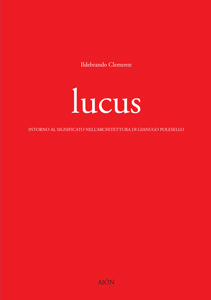
The notion of lucus and the architecture of Gianugo Polesello
This book deals with the forms and meaning in the architecture
of Gianugo Polesello, from an apparently eccentric view of the
discipline, but precisely because of this, determining a remoteness of
vision that discerns fundamental issues and problems in architecture as
a whole.
Not here will the reader find all-encompassing discursive narratives of
the historiographical tale, nor a mere “pure visibility”
reportage of the formal quality of the work of this architect from
Friuli. On the contrary, the theoretical-formal node that the
architecture of Polesello wove undergoes the scrutiny of an
investigation that focuses on the reasons for its occurrence: firstly,
by rescuing it from a reductionist interpretation of the role of
abstraction in gestating the forms; the geometric beauty of pure
volumes, the strict system of the vacuum and its urban spaces, the
metric ostinato repeating figures already given, these are incidences
identified as the opening moves in the jigsaw of the composition and
the beginning of a game that carries us towards the mythical and
emotional core of Polesello’s architecture. Thus, the story
unfolds in a journey toward a possible prehistory of pure forms revoluted to archetypes; and it is precisely the archetype of the lucus,
the grove/glade that the author identifies as a dialectical image
through which volumes and spaces are removed from the blinding glare of
laconic abstract poetics, and ascribed to the unutterable enigma of the
symbolic sphere. The lucus
therefore stands at the centre of this book and rightly gives it its
name; the significance of this archetype proceeds from the image of the
forest, which was already the origin of the city in Vitruvius,
constituting the wellspring of urban space and the start of the
potential of architectural forms; the impenetrable grove is therefore
closely accompanied by the otherness of the glade, as an act of
deforestation that conveys light into the inner recesses of the lucus. The symbolic space of the grove/glade is therefore the interpretative mirror of Polesello’s architecture.
Ildebrando Clemente explains this research hypothesis through a
reasoned presentation that is far from Cartesian; the references to
myth, the history of ideas, philosophy, etymological chains and the
genealogy of forms advance hand in hand, stratifying without fearing
any obscurity, and allowing some deliberate omissions; however, the
enigma of pure forms in Polesello’s architecture, if not
divulged, is undeniably brought to light in this way and swathed within
a rich constellation of sense. Above all, the opening into the symbolic
sphere which this study proposes is able to justify the intimate civil
essence of his design approach. The original act of space-making, which is the glade, and the beneficium
in providing a habitable place for the life of man – finally
protected from some harshnesses of nature – legibly latches onto
the centrality of the order of the vacuum of his projects, of space-making as monuments.
Consequently, also the importance and peculiarities of Polesello's
experience within the great urban study season can be grasped, the ways
in which he understood the possibility of recognizing and preserving a
community; at the same time, in the sophisticated otherness of the
geometric shapes with respect to the non-fabric of the suburbs, we
catch a glimpse of a different possibility of land use. An ethical
instance therefore goads the attempt to avoid a total reification of
the earth as a pure object of consumption, to reconsecrate it to man.
These are some of the themes we seemed to discern in this book, which,
as we press forward around the meaning in Polesello’s work, open
and raise still current questions on the founding conditions of
architecture and cities. Is it possible to propose a design as an
illusion of dominating reality even now? Or does the unquenchable
implication with the sacred dimension that man-craftsman carries in
himself not lead us back towards the fertile opening with the risk of
an indomitable space?
Francesco Primari
Title: Lucus
Subtitle: Intorno al significato nell'architettura di Gianugo Polesello
Book Series: Saggi di architettura
Language: italian
Publisher: Aion, Florence
Characteristic: dimension 17x24 cm, 254 pages, paperback, color, b/w
ISBN 9788898262434
Year: 2016